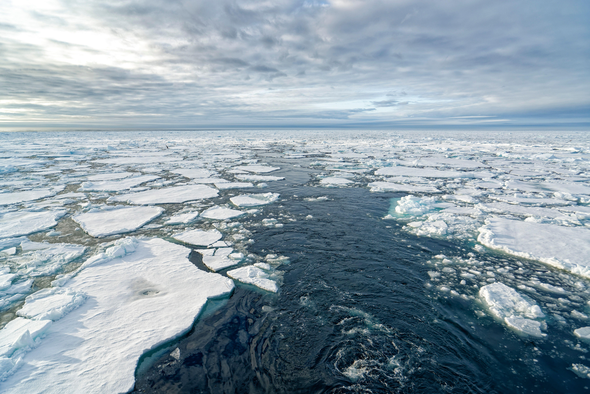
A new scientific method may allow researchers to keep better tabs on the melting Arctic. For the first time, scientists have devised a technique to monitor the thickness of Arctic sea ice year-round — even in the summer, when it’s most difficult to do.
The new method, outlined in a paper published Wednesday in the journal Nature, may help to fill a longstanding gap in the satellite record when it comes to sea ice thickness.
Since 1979, scientists have used satellites to keep a continuous eye on Arctic sea ice. Satellite images, collected year round, show how the total sea ice coverage area has steadily shrunk as the planet has warmed.
Special radar instruments on satellites also can measure the thickness of sea ice as it floats atop the ocean. These records suggest that sea ice is thinning over time as much of the Arctic’s oldest, thickest ice succumbs to the warming climate.
But there’s one major issue with the thickness record. It largely excludes the summer months.
During the warmest time of the year, the sea ice begins to melt and liquid water begins to pool on its surface. These melt ponds confuse the radar systems, making it difficult for them to differentiate ice from ocean and to accurately measure the thickness of ice floes.
There are other ways scientists can measure ice thickness during the summer. They can fly specially equipped planes over the Arctic Ocean, or they can send researchers into the field on ships to take the measurements in person. There are even special scientific buoys scattered throughout the Arctic that can help keep tabs on the changing ice.
But none of these methods provides the kind of complete, continuous picture of the entire Arctic Ocean that satellites do. That means there’s always something of a gap in the thickness record during the summer.
That’s a problem from a scientific standpoint. Complete, nonstop records are the gold standard for understanding how the Arctic is responding to climate change and for building climate models that can make long-term predictions about its future.
It’s a problem that Jack Landy, lead author of the new study, has pondered for several years now.
After wrapping up his doctorate in Canada, Landy was looking for new projects to tackle. He’d just moved back to the United Kingdom and was finding that there were fewer opportunities for the kinds of field-based research he’d conducted while he was overseas. He started thinking about problems that could be solved from afar.
“This was one of the clear kind of gaps in the knowledge that we had,” said Landy, currently a scientist at University of Tromsø — The Arctic University of Norway. “There’s been, for more than 20 years, this gap in summer thickness observations that we get from satellite altimetry. So it just seemed like a really interesting and exciting project to try to target.”
It also proved a major challenge.
“The reason that it’s taken so long has been that it’s a very challenging project to get good results on,” Landy said.
Over the last few years, more collaborators got involved with the project. The new paper, published this week, includes a dozen authors from institutions across Europe and North America.
The team turned to machine learning, a kind of artificial intelligence, for the solution. One of the fundamental challenges for measuring ice thickness in summer is differentiating between melt pools on the ice and the ocean itself. The researchers applied a machine learning technique to satellite data to distinguish the ice floes.
They also built a model of the radar system’s response to the melting ice and compared it with actual satellite data — a technique that allowed them to make corrections to the radar system’s measurements as necessary. This method ultimately helped them construct an accurate summertime record of sea ice thickness.
When looking at the complete, year-round record, the scientists found that sea ice thickness is a good predictor of sea ice extent, or the total area it covers on the ocean surface. Thinner ice, unsurprisingly, melts and disappears faster.
The study suggests that data on sea ice thickness during the summer can help predict the total area of ice that’s left over in September, when the summer ends. That’s useful when making forecasts for shipping traffic.
The new method could prove useful in other ways, too.
It can help improve the model simulations that scientists use to make projections about the Arctic’s future. Shrinking sea ice affects the Arctic’s delicate ecosystem and the human societies who depend on it. It also affects the rate at which the Arctic warms. And the speed of Arctic warming, studies suggest, can affect weather and climate patterns elsewhere around the globe. That makes these projections important not only for Arctic communities but for the entire world.
Improving the models is “one of the most exciting potential impacts” of the study, according to Landy. So far, much of the ice thickness data that’s been used to construct the models comes from wintertime observations. The new method opens up the possibility of using the best data from all year.
“All the processes that control how the ice breaks up in the summers have had no thickness data to test against,” Landy said. “The rate of sea ice melting, how much it breaks up and shatters and thins — all these things have been missing observations.”
Reprinted from E&E News with permission from POLITICO, LLC. Copyright 2022. E&E News provides essential news for energy and environment professionals.
"now" - Google News
September 16, 2022 at 02:40AM
https://ift.tt/JHzFdPr
Scientists Can Now Monitor Thinning Sea Ice Year-Round - Scientific American
"now" - Google News
https://ift.tt/sEezX5I
Bagikan Berita Ini














0 Response to "Scientists Can Now Monitor Thinning Sea Ice Year-Round - Scientific American"
Post a Comment